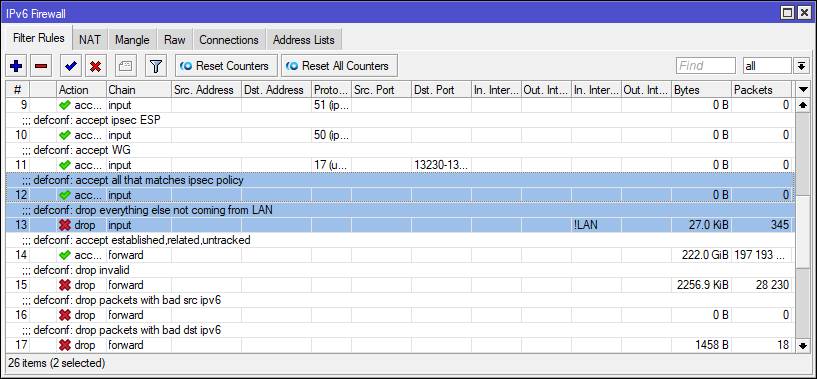Another update on IPv6, especially for Telekom Malaysia Unifi has different IPv6 deployment. When you doing SD-WAN IPv6 Tunnel like EoIPv6, IPIPv6, it appear Unifi can’t able to connect to each-other.
This because TM-Unifi using RA (Router Advertisement) for Gateway IP Address and DHCPv6 Client for LAN assignment.
I not sure why TM didn’t use DHCPv6 for both, Maxis and TIME able to do it.
In this guide, I assume you have correctly setup Mikrotik at least working basic internet with default configuration and name!
Enable IPv6
Before we start, double check if your Mikrotik has IPv6 enable and accept RA via IPv6 ➡️ Settings:

Click 🆗 then reboot Mikrotik to take effect!
Check RA
Once Mikrotik fully booted, navigate to IPv6 ➡️ Addresses then verify Interface pppoe-out1 has IP:
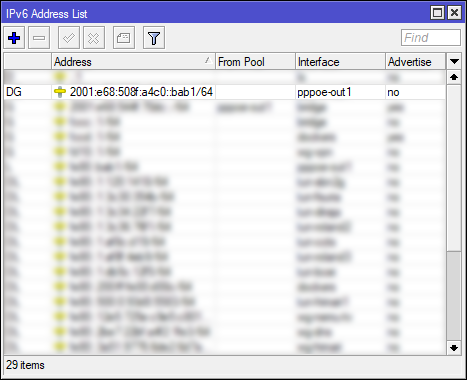
If you see like this, this mean your Mikrotik has received IPv6 from PPPoE via RA!
DHCPv6 Client
Now, let your LAN to have and enjoy IPv6 Address!
- Navigate and Click IPv6 ➡️ DHCP Client
- Click ➕
- Follow this:
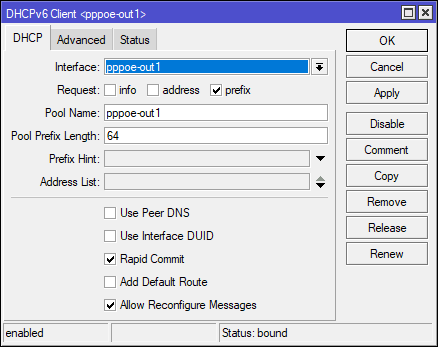
- Navigate and Click IPv6 ➡️ Addresses
- Click ➕
- Follow this:
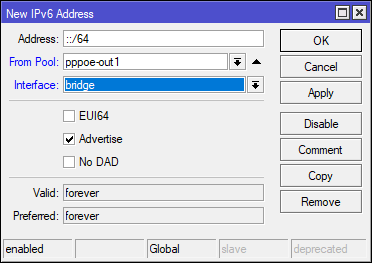
Now, your LAN device has IPv6!
Not yet!
If you planning to use SD-WAN via IPv6, you need fix route problem, because Mikrotik has two IPv6 address can use, which is pppoe-out1 and bridge, by default due to default Distance, Scope & Target Scope make use if bridge IPv6 Address, which is invalid for Mikrotik use and SD-WAN traffic will be forwarded to LAN instead of router it self!
To fix this, navigate to IPv6 ➡️ DHCPv6 Client and Open pppoe-out1 Advanced then follow this:

delay 5
/ipv6 route remove [/ipv6 route find dst-address=::/0 gateway=pppoe-out1]
delay 10
/ipv6 route add dst-address=::/0 gateway=pppoe-out1 distance=1 scope=1 target-scope=1This will automatically delete default route and add with high priority routes! This ensure Mikrotik it self use pppoe-out1 ND IPv6 Address while maintaining LAN IPv6 via bridge routing.
This script will resolve DHCPv6 3 days lease automatically!
Then click 🆗 to apply!
Verify
To verify that your Mikrotik use pppoe-out1 IPv6 Address, run this on the Terminal see output result
/tool fetch url="http://api6.ipify.org/" output=userOutput should be like this, a pppoe-out1 RA address:
status: finished
downloaded: 0KiB
total: 0KiB
duration: 0s
data: 2001:e68:508f:a4c0::bab1Check data and compare from IPv6 Addresses:
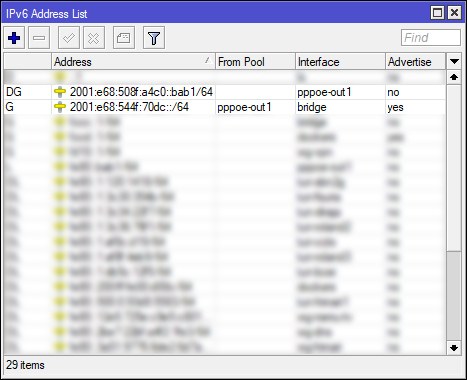
It should be use pppoe-out1 Interface IPv6 Address instead of bridge
If didn’t work, try adjusting the pppoe-out1 Default Route Distance:
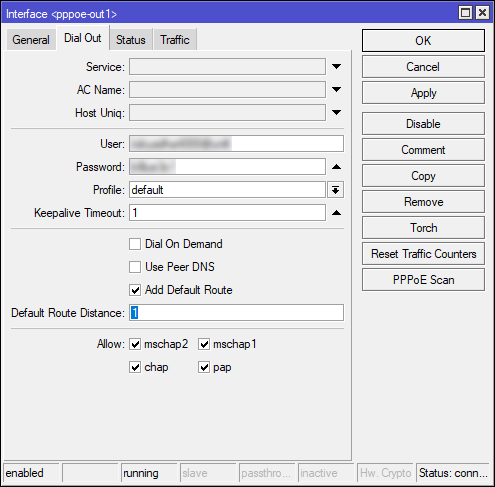
For Fun Hex
Since Mikrotik ROS 7.17rc3, you can add Link Local Address to have custom IPv6 Address, to achieve this, simply go to IPv6 ➡️ Addresses and click ➕
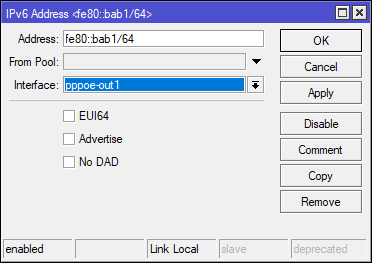
You can use any valid Link-Local Address, format should be:
fe80::aaaa:bbbb:cccc:ddddany hex number between a b c d, here some fun hex word:
- cafe
- dead
- beef
- c0de (code)
- f1ee (flee)
- feed
- b00b (boob)
- c001 (cool)
- fefe
- fafa
- face
- b00c (book)
- da7a (data)
- ca75 (cats)
Make some sentence:
fe80::dead:ca75:cafe:b00bdaad cats, cafe boob
Firewall
To make EoIPv6, IPIPv6 and GREv6 (also Wireguard), you need to set IPv6 Firewall these protocol:
Chain: input, Action: accept
| Protocol | Destination Port | Comment |
| 41 (ipv6-tunn) | IPIPv6 | |
| 47 (gre) | GREv6 | |
| 50 (ipsec-esp) | EoIPv6 | |
| 51 (ipsec-ah) | EoIPv6 | |
| 94 (ipip) | IPIPv6 | |
| 17 (udp) | 500,1701,4500 | IKE for EoIP |
| 17 (udp) | 13230-13299 | Wireguard |
Make sure move these rules before (above) of defconf: drop everything else not coming from LAN and defconf: accept all that matches ipsec policy
